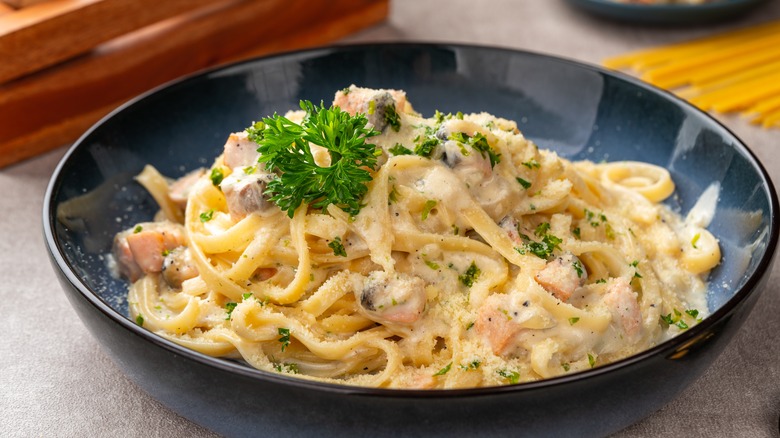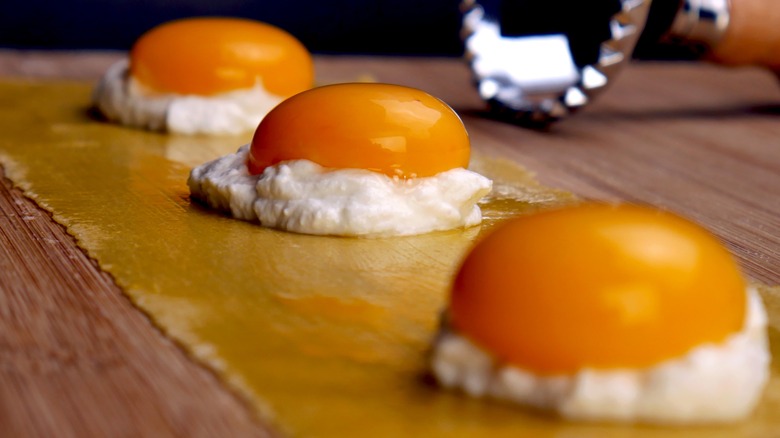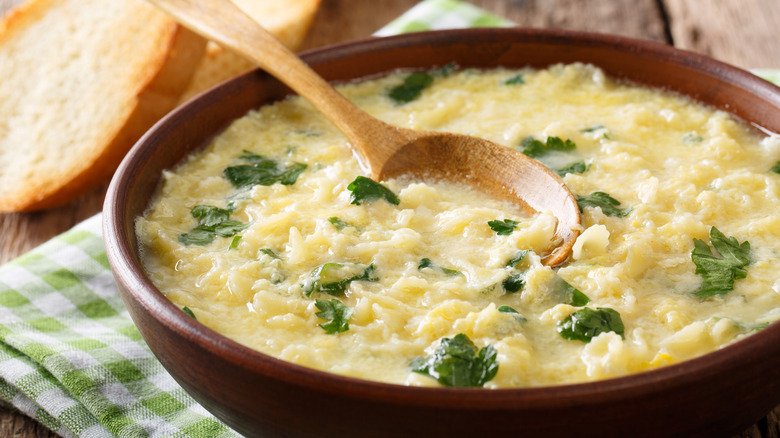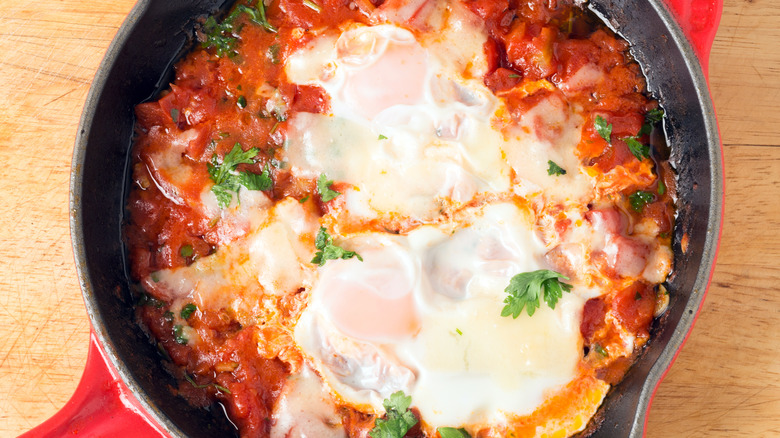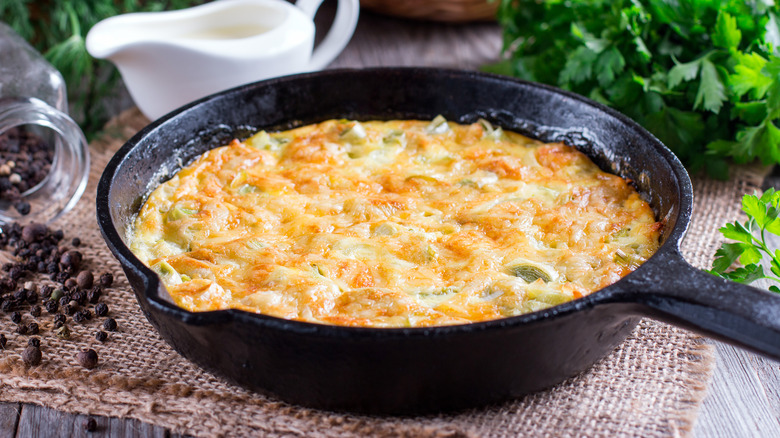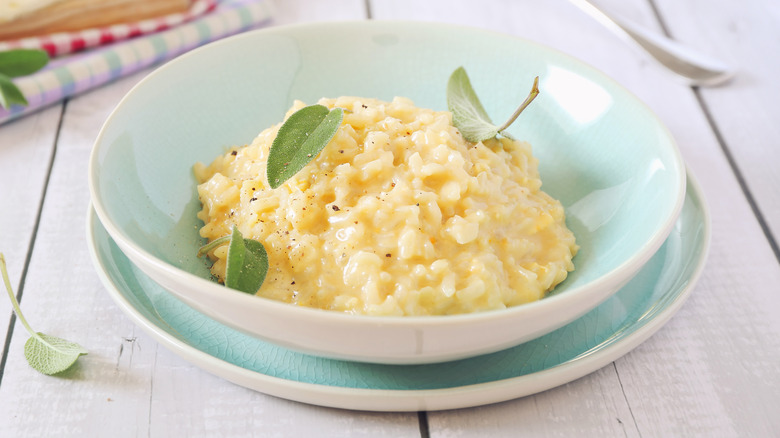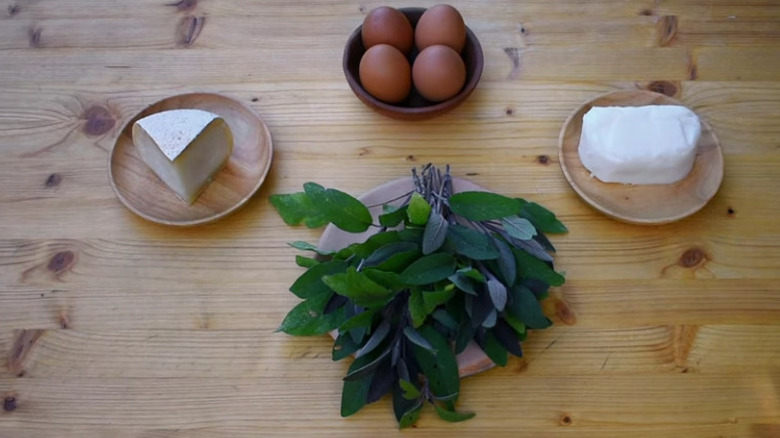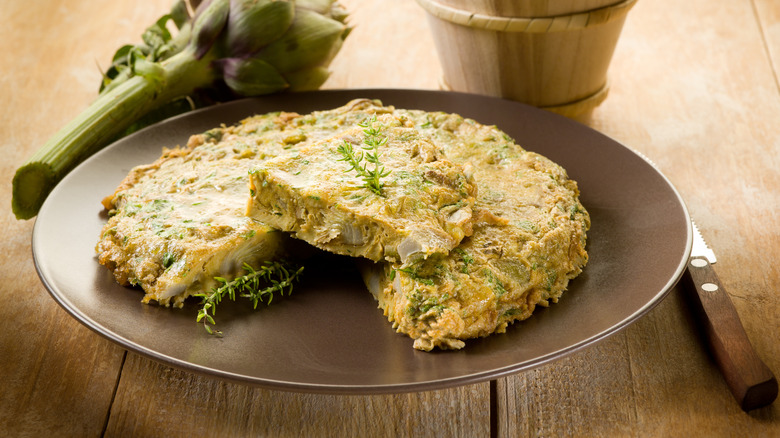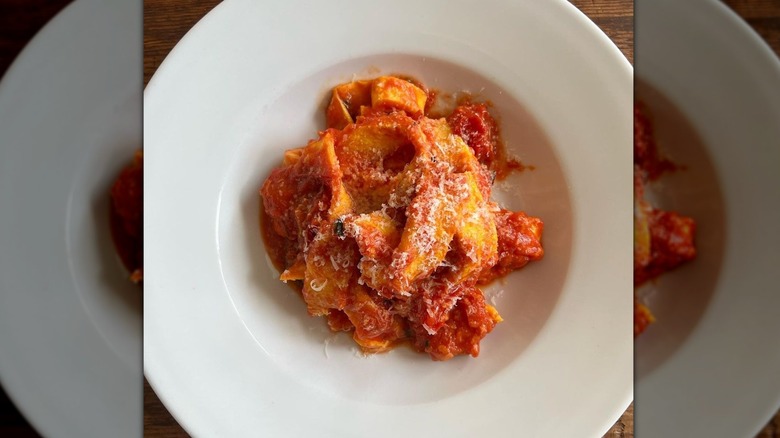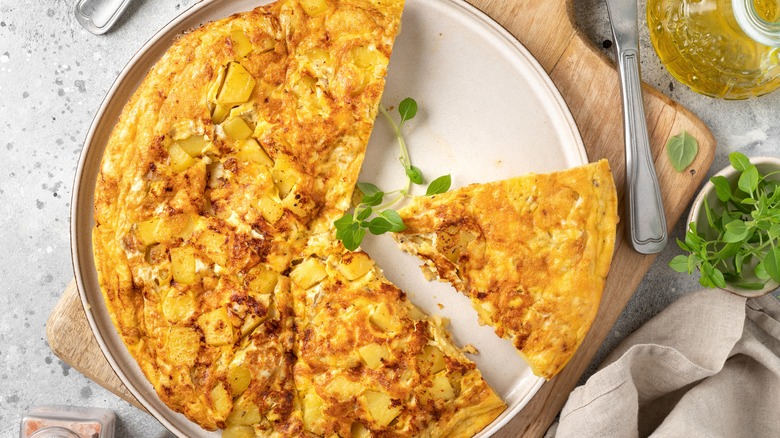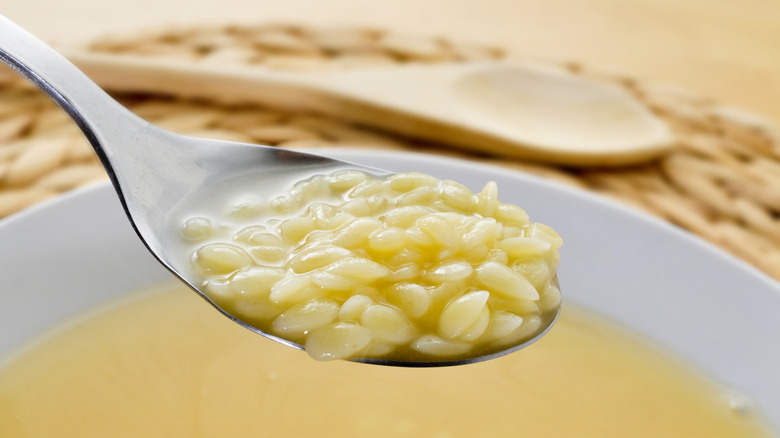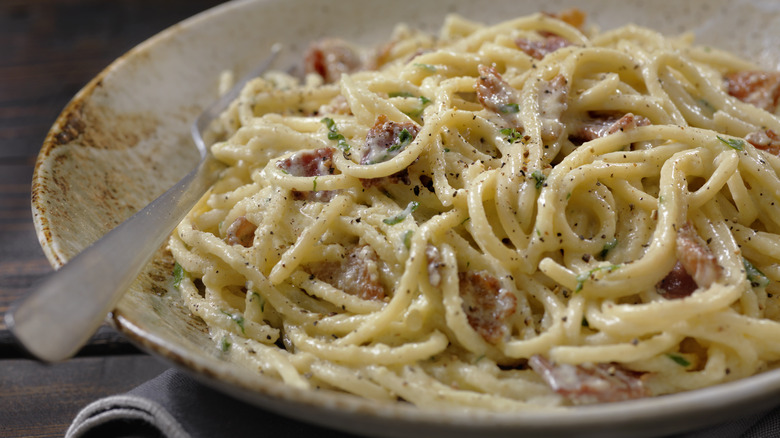15 Egg Dishes From Italy You Need To Try Once
Eggs are a magical ingredient. They make cakes fluffy, cookies chewy, sauces thick, and, of course, they're the star of breakfast. Eggs' many forms make them a culinary staple all over the world. In Italy, they're enjoyed morning, noon, and night. From pasta sauce to winter cocktails, eggs are the core of dozens of Italian recipes that deserve some serious appreciation.
Italian cuisine is all about simple food with the most incredible, fresh ingredients. There's a reason pasta and pizza have become some of the most common "quick meals" around the globe, and that's because they're rather straightforward to prepare. The secret is in the sauce, as they say. Italian chefs will go to bat for their recipes because it's just one little touch that can make all the difference. These timeless egg dishes are no different, but luckily they've been adapted by many brilliant chefs over the years, and what we can't recreate will just have to be enjoyed in the country itself. Italy, here we come.
Raviolo al' uovo
If a perfectly runny egg yolk is your style, raviolo al' uovo should be on the menu. Egg yolk is typically reserved for the pasta dough, but not when it comes to this Italian raviolio. Thinly rolled pasta dough is filled with a dollop of ricotta cheese and an egg yolk, staying perfectly intact. Once served, the yolk is miraculously still runny and the result is the most perfect pocket of rich, creamy goodness that melts in your mouth.
Raviolo is basically one giant round pocket of pasta, whereas ordering ravioli will present you with a plate full of smaller square ravioli. Given the hefty size, it's rather perfect for a solitary egg yolk. It makes for an ideal appetizer, or a hearty meal if a few raviolos are eaten with gusto. The dish is a traditional one that has been served all over Italy, from the north of the country to Rome. Our Tasting Table raviolo al' uovo recipe has a citrus element that really makes each bite pop with a burst of flavor.
Pizza rustica
Holidays always call for pie, but what about pie for dinner? There are plenty of savory pies out there; shepherd's pie, meat pie, and chicken pot pie, just to name a few. In Italy, the take on an Easter pie is on the savory side, and it is even breakfast-friendly. Pizza rustica may have similar tomato-based flavors but it's far from a pizza pie. It's a baked egg casserole packed with Italian meats and cheeses.
Much like other holiday favorites, pizza rustica is widely adored and anticipated every year when Easter rolls around. As Tasting Table Jessica Morone says, "My favorite thing about this recipe is that it reminds me of a traditional Easter dinner with my Italian grandmother." We're thankful that this Italian specialty has made its way to other corners of the world, for more reasons than one. Not only is it a scrumptious addition to a brunch feast, but it's a great honor for the Italian culture.
Stracciatella alla Romana
Egg drop soup is one of those simple dishes that every culture has adapted in its own way. In Rome, the warming gentle soup is named after its city, stracciatella alla Romana. The Roman comfort food features long ribbons of soft, cheesy eggs and showcases Italian flair with delicate herbs and regional nuances. Aside from the unmatched deliciousness, the popularity of this soup may have something to do with the simplicity of its ingredients. With eggs, some good quality chicken stock, thyme, basil, a bay leaf, lemon, Parmigiano, and the usual salt and pepper, this healing soup comes together.
Egg drop soup, or any recipe that calls for cracking eggs right into hot water for that matter, can certainly be intimidating for a novice chef, but practice makes perfect. We recommend slowly adding the egg concoction to the simmering broth with a steady hand. By pouring the eggs into the stock gradually, whisking as you go, you'll create the ultimate simmering pot of egg drop soup, rather than a soupy, scrambled egg disaster. Eggs cook in a matter of seconds, so it's all about finding the equilibrium of heat and movement.
Uova in purgatorio
Uova in purgatorio is a delicious Italian rendition of baked eggs. The clever name, eggs in purgatory, alludes to the eggs being at the center, trapped by a moat of thick tomato sauce. Baking may be one of the easiest cooking methods when it comes to eggs, and for some reason, it's often a neglected option when it comes to breakfast. Understandably, waiting for the oven to preheat can be a nuisance, especially in the early morning, but being able to step away from cooking eggs isn't a common luxury.
This baked dish allows eggs to slowly cook to perfection while simmering in a robust sauce. The eggs essentially poach in the sauce, absorbing every bit of flavor. The sauce, made of tomatoes and traditional Italian seasonings, is finished on the stove before the eggs are cracked right in the middle, making their way into the center of the pan and creeping into nooks and crannies, and tossed in the oven. In true Italian fashion, Uova in purgatorio is typically served with a huge chunk of bread for scooping up every last bite.
Frittata di cipolle
Frittatas are Italy's love letter to breakfast. Many will argue the differences between a frittata and an omelet, and the majority of statements will differ. In the States, when we hear omelet, we typically think of eggs carefully cooked on a stovetop and folded into a half-moon shape. This common dish is a French omelet, but other countries have their own spin on the hearty egg dish. In Italy, it's a frittata. Since frittatas aren't folded with precision, they don't require as much attention during cooking time and can be pan-fried or tossed in the oven.
One of the most common breakfast dishes in Italy is frittata di cipolle, an onion frittata. The dish may be egg-based, but the onions are what really stand out in each bite. They're thinly sliced and slow-cooked in olive oil until they reach a soft, lightly caramelized state. Smooth, beaten eggs are then poured atop until the sides begin to take shape and a gorgeous, golden color begins to appear. After a flip or two, voila, the perfect Italian frittata is made.
Risotto all'uovo
Risotto is a dish that seems simple but is, in fact, very particular. It takes attention and precise execution to master the perfect, rich risotto. Traditional Italian risotto is rice delicately cooked with a flavorful stock and white wine, but this twist on the classic is creamier, if that's even possible. While technically any rice could be used to stir up Risotto all'uovo, Arborio rice is the ideal grain to use for risotto. Since the dish is defined by its creamy nature, a short, high-starch option is key and Arborio rice fits the bill.
Rather than toasting dry rice with butter and onions, risotto all'uovo requires blending the rice with a mixture of whipped eggs, grated Parmigiano-Reggiano, and just the right amount of salt and pepper. The simple dish is perfect as is, but it also works as a great foundation for heartier variations of spices, veggies, and more.
Salviata
This sage-baked omelet is an incredibly special dish that dates back thousands of years. Salviata originates from Florence and honors the unique herb tenfold. Sage has been seen as a powerful heal-all in herbal medicine for thousands of years, explaining its popularity in ancient cuisine. Salviata might sound similar to the Italian word for sage (salvia) but it actually translates to "saved," which could be a nod to preserving a plethora of fresh sage, or perhaps saving one's health thanks to the dietary benefits of the ancient Italian herb.
The sage-forward omelet is said to have been an Italian medieval classic, which adds up given it lacks some of Italy's more celebrated regional ingredients such as tomatoes. With a meal this ancient, there's bound to have been some lost, rearranged, and modified steps throughout the years, which just means more variations for everyone to enjoy, like many Italian meals today.
Frittata di carciofi
Unlike frittata di cipolle, frittata di carciofi is a bit of a lengthy endeavor. Using fresh artichokes here is a must, but that does mean committing to the prep time. Even so, the effort is worth it to truly taste the complex, earthy flavors.
Americanized frittatas found in diners scattered across the country are often packed with a laundry list of ingredients, which isn't necessarily a bad thing, but it's an entirely different approach to the Italian egg bake. Cooking up a frittata does present a great opportunity to use up those old veggies in the fridge, but less is more when it comes to Italian recipes. As expected with Italian-style cooking, a traditional artichoke frittata doesn't need much else. The late Naomi Barry, an Italian food writer who made her way to N.Y.C. in the 1930s, speaks of the nostalgia for certain dishes she and her fellow Italian transplants held in her cookbook, "Food alla Florentine," and an artichoke omelet made them all feel right at home.
Uova in trippa
There may be less talk of it today when discussing Italian favorites, but sliced tripe in tomato sauce was once a typical comfort meal in Italy. Thanks to the filling nature of tripe and its low price tag, it was a great way for low-income Romans to stretch their dollar, but over the years, trippa alla Romana has morphed into a beloved and iconic recipe in Italian gastronomy.
While tripe isn't for everyone, this is the definitive Italian recipe for anyone who appreciates beef tripe. The sauce — tomato, mint, white wine, and pecorino cheese — is divine. The good news is, there are alternatives for those that can't stomach... stomach. A popular twist on the Roman delicacy is uova in trippa, which substitutes the slices of tripe with slices of baked egg. This recipe is a fun option that allows anyone to enjoy the unique flavors of the traditional dish while keeping it vegetarian.
Il Bombardino
There's nothing better than a hot drink on a wintery day, and extra points if it's spiked and during the holidays. Il Bombardino translates to "The Bomb" and it has every right to dub itself so. This boozy eggnog is Italy's gift to the season. The cocktail was born in Northern Lombardia and is now a menu staple all over the Italian Alps. It originally consisted of whiskey, milk, and the Italian custard, zabaglione. It's said to have been created on a whim to warm up some frigid skiers who responded with some serious enthusiasm.
Today, there is a plethora of creamy liquors that mimic the sweet desserts of the world which makes it easier to whip up fun cocktails without having to worry about varying mixer consistencies. A classic spiked eggnog is made with milk, cream, sugar, rum, and of course, eggs. This Italian version opts for an egg liqueur rather than actual eggs and brandy as opposed to rum. The result is a thinner consistency, making for an easier sipping cocktail that doesn't fill you up. One to two glasses of an egg-heavy nog will about do it, but a few more of "The Bomb" could surely be enjoyed.
Zabaglione
Many regions of the world have their own creamy, custard treat and Italy's has got to be zabaglione. The decadent custard is so thin, it almost feels as though it can be sipped as a drink. This shines a light on the epiphany behind Il Bombardino, as this is that secret creamy ingredient that inspired the cocktail. This might be Il Bombardino sans whiskey, but it's just as much of a treat and even has a boozy kick.
The delicate dessert is made with egg yolks, sugar, and Marsala wine, typically garnished with fresh berries and mint, and sometimes crushed amaretti cookies (yum). When cooking with alcohol, the heat will cook its properties off, but with a no-bake recipe like this, a good amount of the alcohol is left in the dessert. It's an iconic confection that dates way back and is an iconic Italian nightcap to cure your sweet tooth.
Rafanata
Considering frittatas are such a standard breakfast choice in Italy, variants of egg pie are a given. Rafanata is home to Basilicata, a mountainous region in Southern Italy. It may appear to be somewhat similar to Spain's tortilla, but only in ingredients. Both are egg-based with potatoes aplenty, but Italian rafanata is made with pecorino cheese and mashed potatoes, rather than thinly sliced, to create an ultra-smooth egg pie.
More importantly, this Italian frittata has a very unexpected ingredient: horseradish. The spicy element is sure to wake the senses, making a slice of the frittata an optimal morning pick-me-up. The unique combination of flavors was discovered during horseradish's high season when households were doing anything they could imagine to use up the fiery root vegetable. It remains a good recipe for using up leftovers, those mashed potatoes from last night in particular. If whipped potatoes are already ready to go, this Italian classic can be thrown together in no time.
Uova ripiene
Uova ripiene, or deviled eggs as they're known in English, are more than just a Super Bowl snack. They may be a hit at potlucks, but they have a regal Italian history. Stuffed eggs of all kinds were a common snack during Medieval times, with fillings ranging from raisins to powdered sugar, but the standard mustard, egg, and paprika filling tied to the devilish name wasn't concretized until the late 1700s. The term "deviled" references food prepared with spicy seasoning, which in this case would be some smoky paprika. Chefs have taken the time-honored appetizer and run with it, with unique creations from wasabi deviled eggs to smoked trout garnishes.
Although, the true origin of the most beloved stuffed eggs is ancient Rome. The Roman appetizer slightly differed in presentation as they weren't originally separated by egg white and yolk, but the same flavor notes seem to have persisted. The earliest deviled eggs were associated with luxury, often served at swanky soirées to high-class guests. Apparently, eggs were the most common starter for the elites of Rome. The finger food's affluent past makes the dish even more fun to enjoy, but thankfully it's not reserved for the rich and famous anymore.
Pastina con l'uovo
Pastina is not only an adorable teeny tiny pasta, but a delicious one at that. The miniature size makes it cling to any sauce you add to it, creating a gooey masterpiece you will keep coming back to. Once an egg is added to the pot, the pasta takes on a whole new level of richness that could put anyone right to sleep. A well-known Italian comfort food, pastina with cheese is often considered not just supper, but medicine. It's probably one of the easiest meals to prepare and can be manipulated in dozens of ways.
One way is an added egg for optimum creaminess. A warm pot of pastina often includes this component, and it can be compared to a Carbonara, as it has a matching paste-like sauce that just melts in your mouth. That unparalleled flavor is all thanks to the one and only egg.
Carbonara
Last but not least, the legendary carbonara. Any trip to Italy wouldn't be complete without this famous pasta dish. Who would have thought that fresh spaghetti tossed with beaten eggs would create such an unparalleled sauce that stands the test of time? The Italians did, and they delivered. The pasta dish is complete with crumbled, crispy guanciale, Pecorino Romano cheese, and fresh black pepper. It would be easy to fool someone into thinking this dish was heavy with cream and butter, but the egg does the work of both those ingredients.
For being such an elegant dish, it's shocking how easy it is to toss spaghetti carbonara together. With ingredients that can be counted on one hand, this five-star dinner could be concocted in a kitchen that isn't even five feet wide. It's undoubtedly a great starting point for expanding your culinary repertoire, as it's easy to master and never fails to impress.
